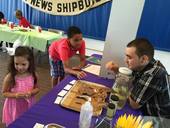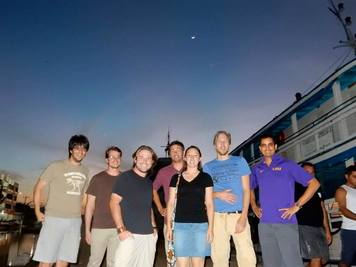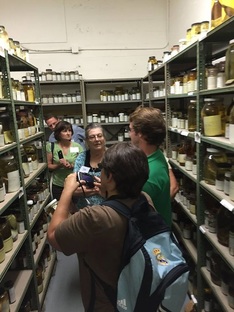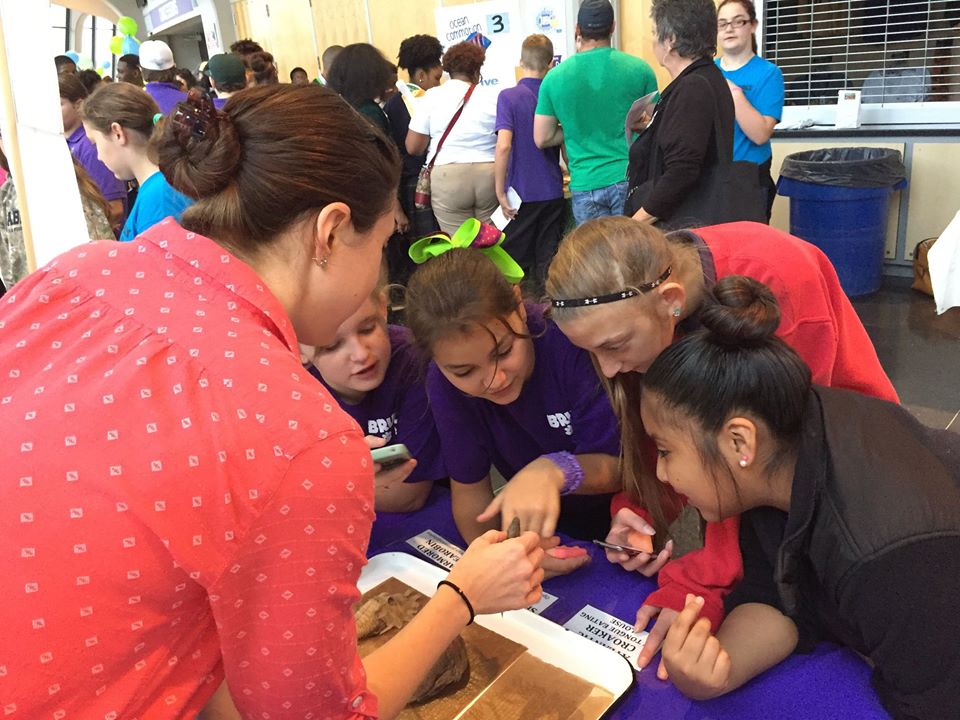 LSUMNS student Zachary Rodriguez showing visitors some local Louisiana fishes LSUMNS student Zachary Rodriguez showing visitors some local Louisiana fishes Since my last post we have been very busy in our lab here at LSU with outreach and collecting events. Right after I got back from Panamá I participated in the 'Our Finned Friends' event at the USS Kidd Veterans Memorial & Museum in downtown Baton Rouge. The event included a free pass for the maritime museum and a free tour of the USS Kidd. We set up an exhibit booth with a couple of things from our collection to show the visitors some of the remarkable fishes they can find in Louisiana. Families would stop by our booth after creating arts and crafts fishes and the booth next to ours, and see some fishes that they have never seen before. It was a great time, and if you ever find yourself in downtown Baton Rouge you should check out the memorial and museum. It's definitely a good place to spend an afternoon.  Our group of Amazon explorers (minus James Albert who was taking the photo) Our group of Amazon explorers (minus James Albert who was taking the photo) Not too long after that outreach event I found myself on another plane headed to Brazil with my advisor, Prosanta Chakrabarty. We had a two week long trip ahead of us, with the plan to spend one week in the field collecting samples on the Amazon, and one week in Guarujá at the 2015 Evolution meeting. Our first stop was Santarém, which is a city located where the Tapajós river intersects the Amazon. The plan was to help James Albert and his lab from University of Louisiana Lafayette collect knife fish samples (Gymnotiformes), among other things, for several projects they are working on. It was the wet season while we were there, and the water level on the river was extremely high. The first night we stayed at a hotel on the river, and the entire road in front of the hotel was flooded! The rest of the nights we slept in hammocks on a boat that we had hired to help us collect. Despite a sudden storm one night that sent the boat rocking, it was some of the best sleep I've had in a while. The collecting went well, and we got a lot of great samples which will eventually be deposited at the LSUMNS. We also got to see a lot of great wildlife while on the river too, including monkeys, a variety of toucans and other birds, and the infamous river dolphins. The area around Santarém is very cool, and I enjoyed walking around the city too. After collecting we headed back towards São Paulo, where we caught a bus that took us to Guarujá, which is a "sleepy" beach town just a couple of hours outside of the city. We spent the last week there walking up and down the beaches, checking out the local aquarium, and listening to great scientific talks at the Evolution meeting. Prosanta gave a poster presentation, and I gave a talk on some of my dissertation work, which were both well received. It was great to meet some new friends, and see how people are pushing the boundaries of science at the meeting.  Showing the visitors the variety of fishes we have in our collection Showing the visitors the variety of fishes we have in our collection After Brazil we have had a couple more outreach events here at the museum. The Louisiana Master Naturalists of the greater Baton Rouge chapter came by and got a very personal tour of the museum. Their tour included short presentations by all of the curators in the morning, followed by hands on experiences in all of the collections. While many of our tours at the museum are focused on younger school children, it was a great change to give tours to older adults who express an interest in Louisiana wildlife. Many already knew many of the local fishes we had in the collection, and they were all excited to see some of the more exotic specimens that our collections hold. They had excellent questions, and it was a great time. They have more tours planned in the future, so I can't wait to help show off our collections to more master naturalists next year! The latest outreach event that we have done is the annual Ocean Commotion event that I have participated in the last two years. I absolutely love this event because schools from all over the greater Baton Rouge area come to LSU and learn about the coastal environment of their state. This year there were over 2,500 kids! As usual, we put out a variety of our strange deep sea fishes that the kids are always shocked to see. This year we decided to include a blob fish that we recently obtained from the University of Washington. It was amazing to see how many of the children already knew what the blob fish was, and how excited they were to see it in person. I really want to thank all of the people who organize Ocean Commotion every year, because it is one of the largest, and most exciting outreach events that I have ever participated in. I can't wait to help out for Ocean Commotion next year. |
Archives
August 2021
Categories |
